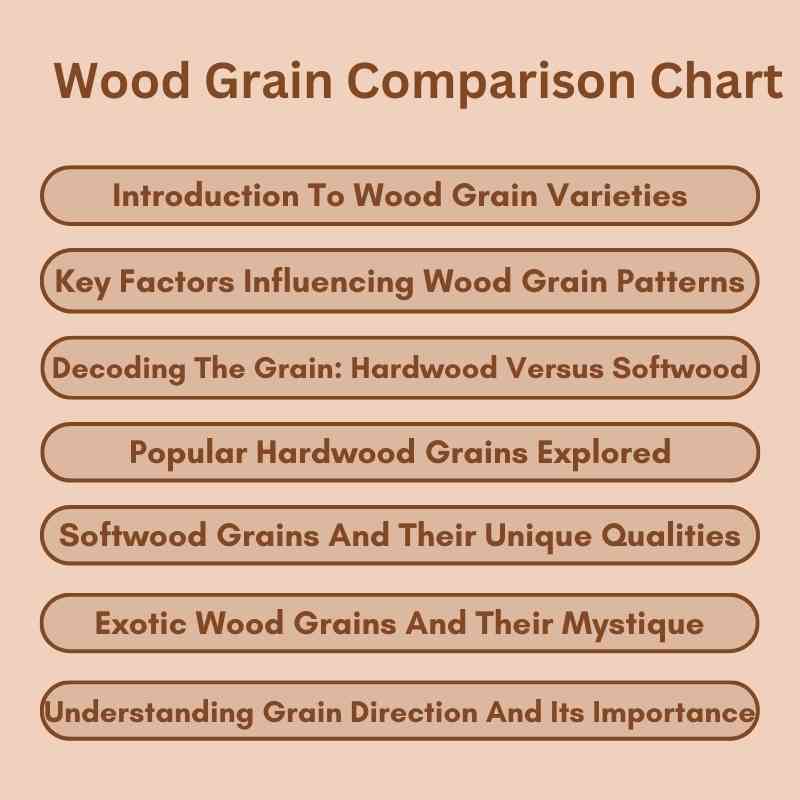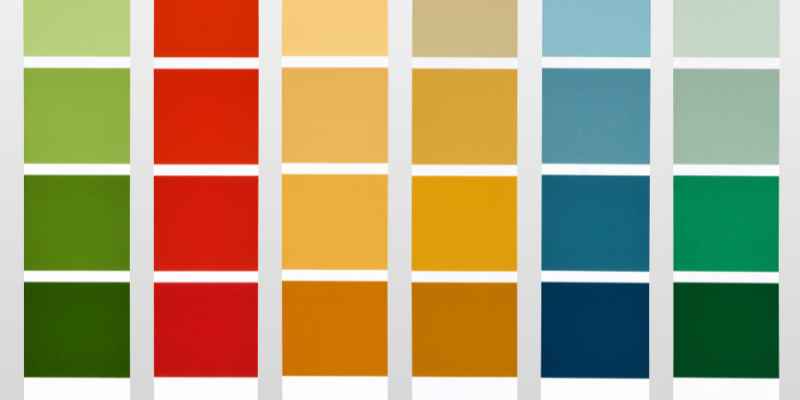A wood grain comparison chart visually represents different wood types and their unique grain patterns. It helps in selecting the right wood for various applications.
Wood selection plays a crucial role in design and construction. Understanding the differences in wood grain can enhance aesthetics and functionality. Each wood type has its distinct texture, color, and grain pattern, influencing not only the final look but also durability.
A well-structured comparison chart simplifies this decision-making process. By clearly displaying characteristics such as hardness, grain orientation, and color variations, it serves as a valuable resource for homeowners, builders, and designers. Knowing these details allows for informed choices that align with personal style and project requirements. Explore the nuances of wood grain to elevate your next project.
Introduction To Wood Grain Varieties
Understanding wood grain varieties is essential for woodworking. Each type of wood has a unique grain pattern. This pattern affects both aesthetics and functionality. Knowing these variations helps in making informed choices.
The Role Of Grain In Woodworking
The grain of wood plays a significant role in woodworking. It influences how wood looks and feels. Different grain patterns can change a project’s overall appeal.
- Visual Appeal: Grain patterns enhance the beauty of wood.
- Durability: Some grains are stronger than others.
- Workability: Grain direction affects cutting and shaping.
Visual And Structural Impact
Wood grain affects both visual and structural qualities. Different woods show unique grains that create stunning effects. Here’s a quick comparison of some popular wood grains:
| Wood Type | Grain Pattern | Common Uses |
|---|---|---|
| Oak | Open grain, bold patterns | Furniture, flooring |
| Maple | Fine, uniform grain | Cabinets, musical instruments |
| Walnut | Rich, swirling patterns | Luxury furniture, carvings |
| Pine | Straight, knotty grain | Construction, rustic furniture |
Understanding these impacts helps in choosing the right wood. Consider both the visual and structural aspects for your projects. Each grain tells a story and adds character.

Key Factors Influencing Wood Grain Patterns
Wood grain patterns are unique. They depend on several factors. Understanding these factors helps in choosing the right wood. Here are the key influences on wood grain patterns.
Species And Genetics
The type of wood species plays a big role. Different species show different grain patterns. Here are some examples:
| Wood Species | Grain Pattern |
|---|---|
| Oak | Bold, open grain |
| Maple | Smooth, fine grain |
| Pine | Wavy, knotty grain |
| Cherry | Rich, straight grain |
Genetics also matter. Each tree has a unique genetic makeup. This influences the grain pattern even within the same species.
Environmental Conditions
Environmental factors shape wood grain. Conditions during growth affect the final look. Key factors include:
- Soil Quality: Nutrient-rich soil promotes healthy growth.
- Climate: Temperature and moisture levels influence growth rate.
- Sunlight: More sunlight leads to denser wood.
- Water Availability: Consistent moisture supports uniform grain.
These factors create unique patterns. Trees growing under different conditions will look different.
Decoding The Grain: Hardwood Versus Softwood
Understanding wood grain is essential for selecting the right material. Different woods have unique characteristics. Knowing these can help in making informed choices.
Characteristics Of Hardwood Grains
Hardwood grains come from deciduous trees. These trees lose their leaves each year. Hardwood is known for its durability and strength.
- Density: Hardwoods are denser than softwoods.
- Grain Patterns: They have complex and varied grain patterns.
- Color: Hardwoods often display rich colors.
- Durability: They resist wear and tear effectively.
Common hardwoods include:
- Oak
- Maple
- Cherry
Their unique features make hardwoods ideal for furniture and flooring.
Traits Of Softwood Grains
Softwood grains originate from coniferous trees. These trees remain evergreen. Softwoods are lighter and easier to work with.
- Weight: Softwoods are generally lighter than hardwoods.
- Grain Patterns: They have straighter and simpler grain patterns.
- Color: Softwoods usually have lighter colors.
- Workability: They are easier to cut and shape.
Common softwoods include:
- Pine
- Cedar
- Fir
These traits make softwoods suitable for construction and craft projects.
Popular Hardwood Grains Explored
Hardwood grains add character and beauty to furniture. Different types of hardwoods offer unique grains. This section explores three popular hardwood grains: Oak, Maple, and Cherry.
Oak Grain Distinctions
Oak is a strong and durable wood. It has a distinct grain pattern that many love. Here are some key features:
- Texture: Coarse and open grain.
- Color: Ranges from light to dark brown.
- Patterns: Prominent rays and medullary spots.
Oak is perfect for furniture and flooring. Its durability makes it ideal for high-traffic areas.
The Elegance Of Maple
Maple is known for its smooth and fine grain. It has a light, creamy color that brightens spaces. Key characteristics include:
- Texture: Fine and uniform.
- Color: Light, often with reddish undertones.
- Patterns: Subtle and delicate.
Maple is often used in cabinets and decorative pieces. Its elegant look fits modern and traditional styles.
Cherry Wood’s Unique Appeal
Cherry wood offers warmth and richness. Its grain is smooth with a natural sheen. Here are its main attributes:
- Texture: Smooth with a fine grain.
- Color: Starts light and deepens over time.
- Patterns: Straight grain with occasional waves.
Cherry is popular for high-end furniture. It ages beautifully, enhancing its appeal.
Softwood Grains And Their Unique Qualities
Softwoods are known for their distinctive grains and textures. Each type of softwood offers unique qualities. Understanding these differences helps in choosing the right wood for projects.
Pine: Versatile And Prominent
Pine is one of the most popular softwoods. It has a light color and a straight grain. Here are some key features of pine:
- Lightweight: Easy to handle and transport.
- Affordable: Budget-friendly option for many projects.
- Workability: Simple to cut and shape.
- Natural Resins: Offers a pleasant scent.
Pine is ideal for furniture, cabinets, and decor. Its versatility makes it a favorite among woodworkers.
Cedar’s Durable Beauty
Cedar wood stands out for its rich color and aroma. This wood is naturally resistant to decay. Here are its notable qualities:
- Weather-Resistant: Perfect for outdoor projects.
- Lightweight: Easy to work with.
- Insect Repellent: Keeps pests at bay.
- Beautiful Grain: Unique patterns enhance aesthetics.
Cedar is great for decks, fences, and garden furniture. Its beauty and durability make it a top choice.
Spruce Patterns
Spruce is known for its fine, uniform grain. This softwood is light yet strong. Here are some characteristics of spruce:
- High Strength-to-Weight Ratio: Ideal for structural uses.
- Good Acoustic Properties: Great for musical instruments.
- Light Color: Offers a bright appearance.
Spruce is often used in construction and musical applications. Its unique patterns add charm to any project.
Exotic Wood Grains And Their Mystique
Exotic wood grains hold a special allure. They showcase nature’s artistry in stunning designs. These woods come from far-off places, giving them unique stories and characteristics. People love them for furniture, flooring, and decor. Each type of wood has its own charm and beauty.
Teak: Luxurious And Resistant
Teak is one of the most sought-after exotic woods. It features a rich golden-brown hue. This wood is known for its durability. Teak is naturally resistant to moisture and insects.
- Ideal for outdoor furniture.
- Requires little maintenance.
- Develops a beautiful silver patina over time.
Its fine grain and smooth texture make it highly desirable. Teak adds a touch of elegance to any space.
Mahogany: Deep And Rich Patterns
Mahogany boasts deep, warm colors. Its patterns are striking and bold. This wood is often used in high-end furniture.
- Red to reddish-brown tones.
- Exceptional workability and finish.
- Highly resistant to warping.
Mahogany’s smooth surface enhances its beauty. It ages gracefully, adding character over the years.
Rosewood’s Intricate Grains
Rosewood is famous for its intricate patterns. This wood features dramatic color contrasts. Shades range from deep purples to rich browns.
- Dense and durable.
- Produces a lovely sound in musical instruments.
- Highly valued for its beauty.
Rosewood’s unique grains make it a favorite among artisans. It adds a luxurious feel to any creation.
| Wood Type | Color | Key Features |
|---|---|---|
| Teak | Golden-brown | Durable, moisture-resistant |
| Mahogany | Red to reddish-brown | Deep patterns, warp-resistant |
| Rosewood | Deep purple to brown | Intricate grains, dense |
Understanding Grain Direction And Its Importance
Grain direction affects the appearance and performance of wood. Knowing how it works helps in choosing the right wood for projects. This section dives into grain direction, its anatomy, and its impact on strength and workability.
The Anatomy Of Grain Direction
Grain direction refers to the orientation of wood fibers. It can be classified into three main types:
- Straight Grain: Fibers run parallel. This type is strong and stable.
- Curly Grain: Fibers twist and turn. This type is often decorative.
- Wavy Grain: Fibers create a wave pattern. This type can be unique and appealing.
Understanding these types helps in selecting wood for specific uses. Each grain type reacts differently to stress and tools.
Influence On Wood Strength And Workability
| Grain Type | Wood Strength | Workability |
|---|---|---|
| Straight Grain | Very Strong | Easy to Work |
| Curly Grain | Moderate Strength | More Challenging |
| Wavy Grain | Variable Strength | Can Be Difficult |
Grain direction affects how wood handles stress. Straight grain offers the best strength. Curly and wavy grains can be weaker.
Workability changes with grain type. Straight grain is easier to cut and shape. Curly and wavy grains can cause tools to tear or splinter.
Choosing the right grain direction enhances the quality and longevity of your projects.
Preservation And Care For Different Wood Grains
Taking care of wood enhances its beauty and longevity. Different wood grains require unique methods for preservation. Understanding these differences ensures your wood remains stunning and functional.
Best Practices For Maintenance
Proper maintenance prolongs the life of wood products. Follow these best practices:
- Regular Cleaning: Use a soft cloth to remove dust.
- Avoid Water: Excess moisture damages wood. Use a damp cloth when necessary.
- Use Coasters: Protect surfaces from spills and heat.
- Apply Wax: Wax adds a protective layer and enhances shine.
- Store Properly: Keep wood away from direct sunlight and heat sources.
Impact Of Finishing On Grain Appearance
Finishing can greatly affect the look of wood grains. Different finishes enhance or mask the natural beauty.
| Finish Type | Effect on Grain | Recommended Use |
|---|---|---|
| Oil Finish | Enhances depth and color | Furniture, countertops |
| Varnish | Creates a hard, glossy surface | High-traffic areas |
| Shellac | Gives a warm, rich tone | Antique restoration |
| Polyurethane | Durable, protects against scratches | Flooring, tables |
Choose the right finish based on your wood type. The right choice enhances beauty and durability. Regular maintenance ensures your wood retains its charm for years.
Tools And Techniques For Enhancing Grain Visibility
Enhancing wood grain visibility adds beauty to your projects. Proper tools and techniques make a big difference. Use the right materials for the best results. Below are key methods to highlight wood grain.
Choosing The Right Sandpaper
Sandpaper is crucial for preparing wood surfaces. The right grit helps reveal the grain.
- Coarse Grit (60-80): Removes rough spots quickly.
- Medium Grit (120-150): Smooths the surface for better grain visibility.
- Fine Grit (220+): Prepares for finishing touches.
Start with coarse grit. Progress to finer grits for a smooth finish. Always sand in the direction of the grain. This prevents scratches and enhances visibility.
Staining For Contrast And Depth
Stains can dramatically change the look of wood. They enhance grain patterns and add depth.
| Stain Type | Effect on Grain |
|---|---|
| Oil-based Stains | Rich colors that highlight grain |
| Water-based Stains | Quick drying, less odor |
| Gel Stains | Thicker, offers more control |
Select a stain that contrasts with the wood color. Dark stains enhance light wood. Light stains soften dark wood. Apply with a brush or cloth. Wipe off excess for an even finish.
Experiment with samples to find the best look. Follow these tips to make your wood grain pop.
Conclusion: The Beauty Of Wood Grain In Design
Wood grain brings unique charm to any design. Each piece tells its own story. It adds warmth and character to spaces. Understanding different wood grains can enhance your projects.
Sustainable Use Of Wood Grains
Sustainable practices are crucial in wood selection. Choosing responsibly sourced wood is vital. Here are some benefits of sustainable wood use:
- Environmental Protection: Helps preserve forests and ecosystems.
- Quality Assurance: Sustainable wood often has better durability.
- Support Local Economies: Promotes local craftsmanship and jobs.
Using sustainable wood grains supports a healthier planet. Every choice matters in design.
Personalization Through Grain Selection
Wood grain selection allows for personalization in design. Different patterns can reflect individual styles. Consider these options:
- Types of Wood: Oak, walnut, maple, and cherry each offer unique grains.
- Grain Patterns: Straight, wavy, or curly grains create different looks.
- Staining Options: Enhance or change wood color to fit your theme.
Choosing the right wood grain adds personal touch to designs. It creates a lasting impression.
| Wood Type | Grain Pattern | Color Range |
|---|---|---|
| Oak | Straight | Light to medium brown |
| Walnut | Wavy | Dark brown to purplish |
| Maple | Curly | Light cream to reddish-brown |
| Cherry | Straight | Reddish-brown |
Explore wood grain options to enhance your designs. Let the natural beauty speak for itself.

Frequently Asked Questions
What Is A Wood Grain Comparison Chart?
A wood grain comparison chart visually represents the unique patterns and textures of different wood types. It helps you easily identify and compare various grains, making it ideal for choosing wood for furniture, flooring, or other projects. Understanding these differences can enhance your design choices and overall satisfaction.
Why Is Wood Grain Important In Design?
Wood grain plays a significant role in design aesthetics. It influences the look and feel of wooden items, contributing to the overall ambiance of a space. Choosing the right grain can complement other materials and colors, enhancing the visual appeal and creating a cohesive design.
How Do I Choose The Right Wood Grain?
To choose the right wood grain, consider your project’s style and purpose. Look at the color, texture, and pattern that best fits your design vision. It’s essential to match the wood grain with surrounding elements for a harmonious look. Experimenting with samples can help you make informed decisions.
Are All Wood Grains The Same?
No, all wood grains are not the same. Each type of wood has its unique grain pattern, texture, and color. These differences arise from the species of tree, growth conditions, and processing methods. Understanding these variations can help you select the best wood for your specific needs.
Conclusion
Choosing the right wood grain can significantly impact your project. This comparison chart simplifies your decision-making process. By understanding the unique characteristics of each grain, you can select the perfect match for your needs. Embrace the beauty and functionality of wood to enhance your space effectively.
Happy crafting!

